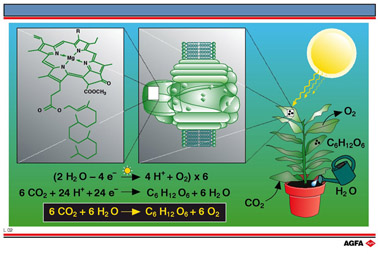L02 Photosynthesis
Aim: To show that chlorophyll is important in the process of photosynthesis and that the formation of glucose is essentially a redox process, i.e. one involving electron transfer |
Photosynthesis is the process by which water and carbon dioxide, under the influence of sunlight, are converted to glucose (and then to starch) and oxygen.
![]()
The photosynthesis reaction is the most important source of energy for
plants (autotrophic) and other living entities (heterotrophic).
The chlorophyll molecule plays an important role in these reactions. It
is located in the chloroplasts and functions as an “antenna”
that receives light-energy. The “tail” of the chlorophyll molecule
anchors it to the wall of the chloroplasts. There are two types of chlorophyll
molecules, a and b: each is a substituted porphyrin ring with a magnesium
atom differing only in the nature of the substituent R. In chlorophyll
a, R is a -CH3 group and in chlorophyll b ,it is a -CHO group.
Both of these molecules absorb part of the sun’s rays, namely in
the red region (![]() = 680...700 nm) and in the blue-violet region (
= 680...700 nm) and in the blue-violet region (![]() = 450...480 nm) of the visible spectrum.
= 450...480 nm) of the visible spectrum.
Neither
molecule absorbs strongly in the green region of the visible spectrum,
these rays being reflected. This explains the green colour of plants.
Upon absorption of a photon of light, an electron of the chlorophyll molecule
is excited to a higher energy level.
To get rid of the excess energy, the molecule transfers the excited electron
to a neighbouring molecule. These electrons eventually end up in the chloroplasts.
The chlorophyll molecule has to replace its lost electron before it can
absorb another photon. This electron is obtained from an H2O-molecule,
via a sequence of reactions.
This reaction sequence can be simplified to:
![]()
The “synthesis” part of the photosynthesis process takes place in the chloroplasts without the need for further light energy. The electron lost by the water molecule is ultimately transferred via a complex reaction cycle, in which various enzymes, energy carriers (ATP) and reducing agents (NADPH) are involved, to a carbon atom, which is thereby reduced. The overall reaction cycle is:
![]()
In order to synthesise a single glucose molecule, this reaction has to be repeated 6
times:
![]()
Reference :
L.F. Fieser and M. Fieser, Organic Chemistry, Reinhold
Publishing Co., New York (1956), pp 484-487
